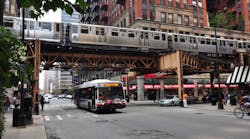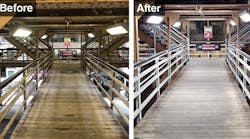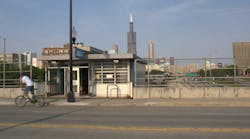CTA releases proposed $1.99 billion 2024 operating budget
An Fiscal Year (FY) 2024 operating budget of $1.99 billion was proposed by the Chicago Transit Authority (CTA) to maintain current fare levels and ensure delivery of bus and rail services, with plans to add an additional service to meet growing ridership demand—all while continuing to make important investments to upgrade and modernize the system.
The proposed spending budget reflects a 9.2 percent increase (or $168.2 million) over FY23's budget and supports CTA’s ongoing workforce initiatives for hiring and retaining key operations personnel while also introducing several new measures that will help improve the overall customer experience with enhanced security and improved Ventra fare system features. This includes a new ChatBot for improved customer service, ongoing work with transit partners at Metra, Pace Suburban Bus and RTA of Northern Illinois to deliver innovative fare products, plus a new, dedicated program that will provide pre-loaded Ventra Cards to victims and survivors of domestic abuse.
“I deeply believe that an examination of an agency’s budget is all that is required to understand who and what it prioritizes. The CTA’s proposed 2024 budget puts a high premium on providing the highest levels of service, customer comfort, modernization and equity,” said CTA President Dorval R. Carter, Jr. “I am pleased with the continued progress and positive trends that CTA continues to make but we still have work to do to provide the service that I believe our customers deserve and expect. I am committed to returning more scheduled service to our bus and rail systems in 2024.”
CTA ridership grew steadily throughout 2023, reaching a pandemic-era high of more than 25.83. million rides during the month of September. Overall system-wide ridership for 2023 is forecasted to finish 12 percent higher than in 2022. Ridership is projected to increase further in 2024, approximately 5.7 percent over the 2023 forecasted ridership.
The continued strengthening of CTA’s workforce is critical to further improving the delivery of its services. In 2023, the CTA made tremendous progress toward addressing this issue, hosting seven job fairs that attracted more than 3,000 potential employees, while hiring hundreds of new workers into a variety of positions. As a result of CTA’s ongoing aggressive recruiting efforts, it has already surpassed its goal of hiring 700 new bus operators in 2023 and anticipates hiring more than 900 bus operators by the end of the year.
CTA is also on track to hire approximately 100 bus mechanics in 2023, which is more than double the normal rate. On the rail side, almost 100 flaggers will have been trained and transitioned into rail operator positions by the end of 2023, which is significantly more rail operators trained than the number of rail operators historically trained in a year.
Overall, CTA is projecting to hire more than 2,000 new employees for the current year, also far exceeding the 1,200 annual hiring norm. CTA will continue to plan, monitor and respond to the shifting employment landscape to meet its people and service needs. As such, CTA anticipates continued optimization of its service schedules to reflect its growing workforce–additional service is expected to be added in 2024.
Since the start of the pandemic, federal funding has been crucial to allow transit agencies across the country, including the CTA, to maintain their operations. Federal funding from the American Rescue Plan will help the CTA close a projected $473 million budget gap in 2024—and allow the agency to continue providing as much service as possible with its available workforce.
“While more and improved funding and investment is unquestionably the most important issue facing CTA finances, our number one priority is always the people who take hundreds of millions of rides on our system every year. It is incumbent upon us to work diligently to find better ways to serve them and improve their travel experience,” Carter said.
The CTA’s 2024-2028 Capital Improvement Program—which is separate from the agency’s operating budget—calls for $3.61 billion in projects over the next five years. This budget reflects CTA’s ongoing commitment towards the modernization and improvement of its physical infrastructure—tracks, rail stations, buses and trains, facilities and technologies. Among the many important investments is the Red Line Extension, which will extend the CTA’s busiest rail line to the southern city limits and will provide greatly improved transit access and connectivity to the Far South Side of Chicago.
Other capital projects to continue or begin in 2024 include:
- All Stations Accessibility Program (ASAP): A total of 14 rail stations are now fully-funded for future accessibility modernization construction work. Of these stations, five are currently under construction, three are in design and five are in various stages of planning. In addition to station improvements, CTA has $37 million in funding for elevator replacements and/or modernizations of existing elevators across the system-up to 16 elevators.
- Bus system electrification: Funds allocated for the full-electrification of the 103rd Garage, plus an allocation of funding for the ongoing Chicago Garage implementation.
- Rail fleet modernization: Increased production of the 7000-series–CTA’s newest generation of railcars, plus ongoing quarter-life overhauls of the agency’s 5000-series.
- Refresh & Renew: Expansion of this annual facilities improvement program to include more CTA employee workplaces while continuing to focus on rail station repairs and enhancements.





